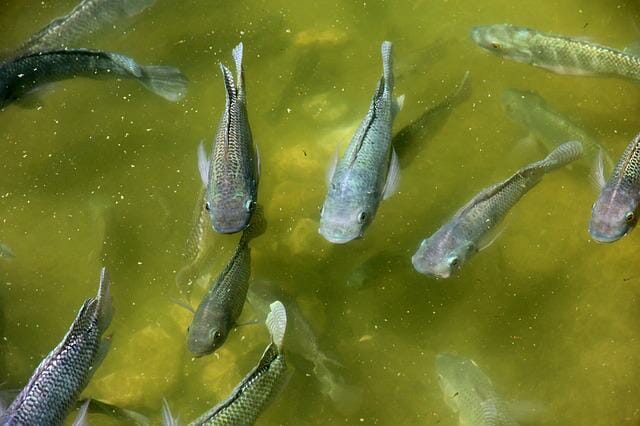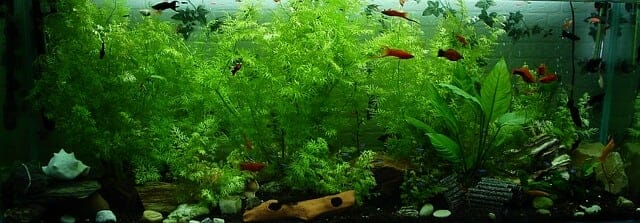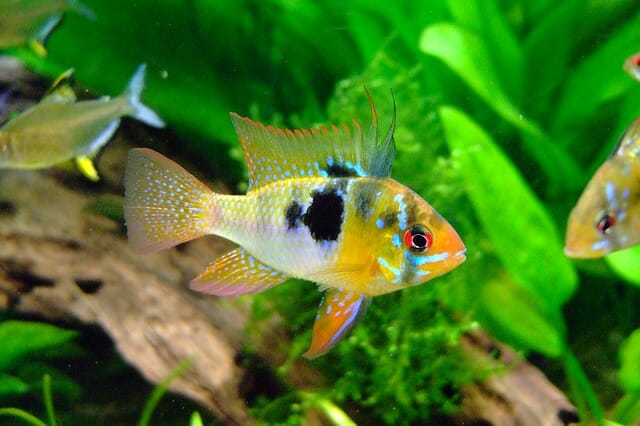Why Is My Cichlid Twitching: Common Causes and Treatment

Cichlids are one of the most popular fish in the tanks of fish enthusiasts worldwide. These fish offer plenty of entertainment value and are also known for their beautiful patterns and colors. Cichlids come in various shapes and sizes to be perfect for just about any aquarium.
The cause of twitching may vary from cichlid to cichlid, but the most common causes include fin rot (a fungus that attacks the fins), parasites, and neuromuscular diseases. These problems can be easily identified and treated with medication or antibiotics. However, if the twitching is severe or doesn’t go away after treatment, it may indicate a more severe condition that requires veterinary care.
Table of Contents
What Is Cichlid Twitching?
Twitching is an expected behavior exhibited by many fish, and various underlying factors can cause it. In general, twitching is usually a sign that something is amiss with the fish’s environment or health.
What Are the Most Causes of Cichlid Twitching?
Fish twitching is typically a result of a variety of different stimuli. Some of the most common reasons for fish twitching include: being handled, getting wet, being scared, or feeling pain. Fish twitch because their body is trying to communicate with you somehow. It may look like the fish is moving around randomly, but in reality, it’s just trying to get your attention.
Poor Water Quality
One of the most common reasons for fish twitching is poor water quality. Poor water quality can cause various problems, including high levels of dissolved oxygen (which can depress the immune system), low nutrients and minerals, and harmful bacteria and fungus. When these conditions exist together, they can lead to fish twitching.
Stress
Stress is a natural response to any situation that causes our body to feel out of control. This can include anything from a sudden change in environment to an intense argument with someone we care about. When stress is constantly experienced, it can hurt our bodies and lead to twitching. Cichlids are especially prone to this type of behavior as they are often subjected to changes in their environment, including adding or removing other fish. When these changes occur suddenly or unexpectedly, cichlids can become overwhelmed and experience physical stress. This leads to twitching as their bodies try to deal with the new situation.
Unstable Water Circulation
Water circulation is an essential part of keeping your cichlid healthy. Too much or too little circulation can cause problems such as the tank becoming cloudy, poor water quality, and fish waste accumulation. When you first set up your cichlid tank, it’s essential to ensure that the water circulates well. You can do this by using a filter or a fish pump. If you don’t have a filter, you can also use a powerhead to circulate the water. If the tank doesn’t have good water circulation, it can lead to poor water quality and fish waste accumulation. Poor circulation can also cause the tank to become cloudy from the gunk floating around.
Overcrowded Aquarium
There are a few reasons why your fish aquarium may be overcrowded:
- If you have more fish than can comfortably live in the tank together, some will be forced to live in less favorable surroundings, such as on the bottom of the sides of the tank. This can lead to stress and aggression among the fish, and they may start to twitch or show other signs of distress.
- If you introduce too many new fish into an already crowded tank, they may compete for food and space with your existing inhabitants. This can also lead to stress and aggression.
- If your aquarium is not adequately heated or cooled (especially in summer), it can create negative fish growth and reproduction conditions.
All of these factors can lead to overcrowding in your aquarium.
Unusual Physical Conflict
Something is attached to his body, and it’s making him twitch. It could be a parasite or some other foreign object, but whatever it needs to be removed. So he’ll need a vet to check him out and get rid of whatever is causing the problem.
Spastic Movements
Cichlids are known to twitch, which is a type of spastic movement. Twitching can be an expected behavior in these fish, but it can also signify something more serious. For example, if your cichlid is twitching abnormally, it’s best to take them to a veterinarian for an examination.
Seeking Attention
Some cichlids will twitch in an attempt to get your attention. This may be a sign of boredom or hunger, so it’s best to check on them and see what might be wrong.

What Should I Do If My African Cichlid Is Twitching?
Your African cichlid may be shivering because of a temperature change or scared. If you think the cichlid is worried, try to calm it down by speaking gently and petting it. Gradually increase the time you spend petting it until the cichlid becomes more relaxed. If the cichlid has a temperature problem, you will need to take it to a qualified fish specialist for treatment.
Make Hiding Spots
One of the most common problems with cichlids is getting stressed out. When they are kept in an overcrowded environment or when their territory is constantly being disturbed, they can become twitchy and irritable. This is often seen as a sign of aggression, but it’s just that the cichlid feels threatened and insecure. One way to prevent this is to create partitions or hiding places for your cichlids. This will give them some space to relax and feel safe, which will help them avoid becoming stressed out.
Check Water Parameters
If you notice your cichlid is twitching, one of the first things you should do is check water parameters. A fish will often wriggle when uncomfortable, and there is something wrong with its water. Checking water parameters can help identify any problems and make the necessary repairs. Here are a few things to check:
- Ammonia levels: High ammonia levels are the first signs of something wrong with your cichlid’s water. If your cichlid is swimming around in its waste, the ammonia levels will be high. Test your cichlid’s water for ammonia using a kit available at most pet stores or online.
- Chlorine levels: Another common sign that something isn’t right.
- Water temperature changes: Fish often twitch when their environment changes suddenly, such as when the water gets too hot or cold.
- Hazards near the fish: If any objects or creatures in the water might scare or bother the fish, they may twitch to ward them off.
- Chemicals in the water: Many chemicals can cause fishes to twitch, especially if they’re sensitive.
Seek Professional Help
There could be many reasons why your cichlid is twitching, and it’s best to consult a fish specialist to get a complete diagnosis. In general, though, the most common causes of twitching in fish are environmental or metabolic stressors, parasites, and diseases. If you can identify and remove the cause of the stressor(s), your fish may recover quickly. If you can’t remember or remove the reason, you may need veterinary help.
